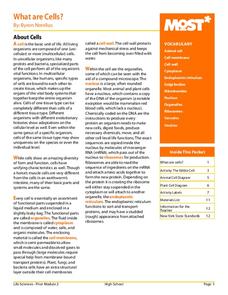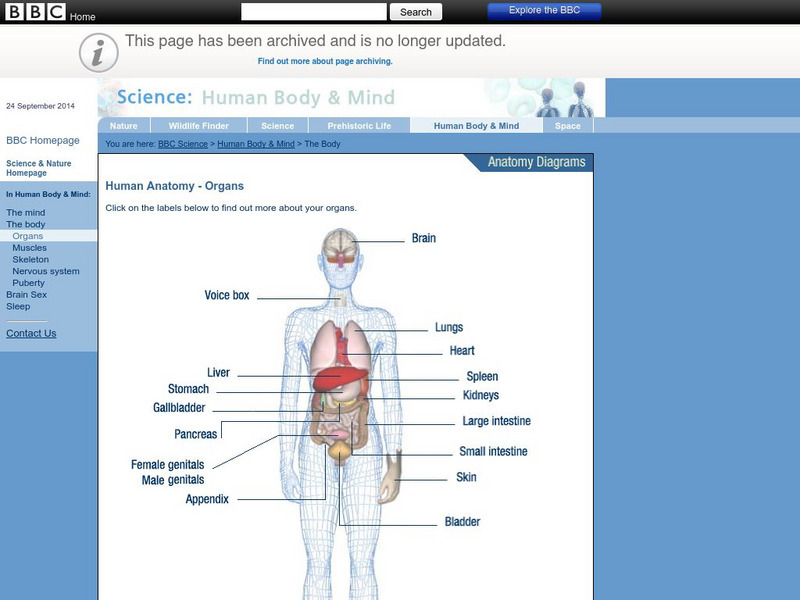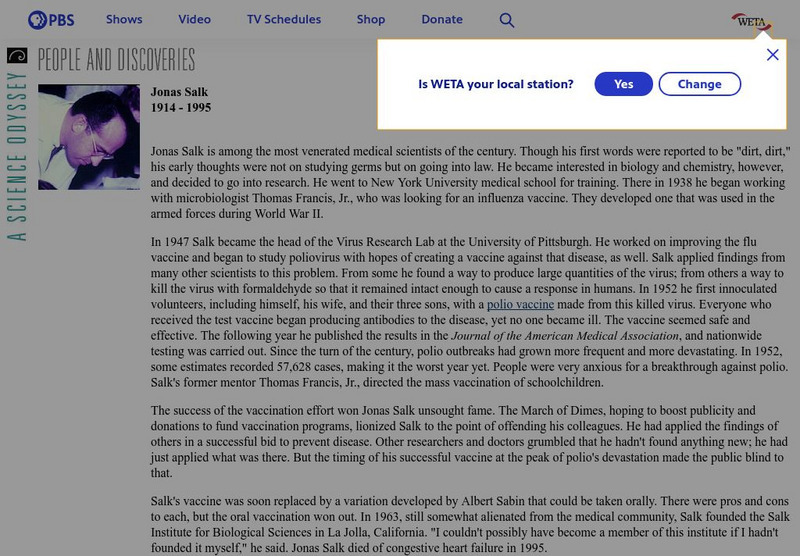It's About Time
Energy Flow in Ecosystems
Emerging biochemists more fully understand the flow of energy in ecosystems as they explore the laws of thermodynamics and relate them to energy transfer in food chains. They also investigate heat loss from the human body and how...
National Institute of Open Schooling
Radioactive Pollution
Radioactive pollutants can enter the body through ingestion, inhalation, absorption, or injection. The last lesson in a series of 36 introduces pupils to radioactive pollution. They study its sources, both natural and man-made, its...
Towson University
Looking Into Lactase: Guided Inquiry
Milk does a body good ... unless, of course, someone is lactose intolerant. Pupils play the role of pharmaceutical scientists in a guided inquiry lab about lactase. Lab groups collaborate to learn more about lactose intolerance, how...
Curated OER
What Are Cells?
Energize the cells of young biologists with an edible life science activity. Engaging students in exploring the inner workings of plant and animal cells, this activity involves using colored jello and various sweet and...
It's About Time
Run and Jump
Has your class wondered how fast a human could run or how high they are capable of jumping? Help them understand these concepts as they explore acceleration and use an accelerometer to make semiquantitative measurements of acceleration...
Scholastic
Heads Up: Real News About Drugs and Your Body
What's the difference between medical marijuana and marijuana bought on the street? Not much. High schoolers learn more about marijuana with an informational booklet that focuses on the medical uses of THC, how marijuana affects the...
University of Texas
What Are Calories?
What are calories, and how do calorie needs differ from person to person? Here is a worksheet that briefly explains how calories measure the energy supplied by food, as well as suggests the amount of food an individual should eat per day.
BBC
Bbc: Human Anatomy: Organs
Explore the anatomy of the human body. Click on an organ or other body part to read more about its structure and function, and then try out an interactive activity for that organ.
Untamed Science
Untamed Science: Human Biology: Musculatory System
Learn about the three types of muscle tissue, how a muscle contracts, and how muscles are adapted for exercise. [3:40]
Khan Academy
Khan Academy: Tissues, Organs, & Organ Systems
Describes the main tissue types and organ systems of the body and how they function together.
Ducksters
Ducksters: Biology for Kids: Muscles in the Human Body
Kids learn about the science of muscles in the human body. How we move and get around.
Ducksters
Ducksters: Biology for Kids: Nervous System in the Human Body
Kids learn about the science of the Nervous System in the human body. Brain, spinal cord, and nerves communicate.
Science Struck
Science Struck: Examples of Chemistry in Everyday Life
Gives examples of chemical interactions occurring in the human body, in the world around us, in foods, and in products we use.
Northwestern University
Di Humani Corporis Fabrica
A historically significant translation of the groundbreaking text on human anatomy that changed the study of anatomy forever.
Science Struck
Science Struck: Organic Compounds List
Explains what an organic compound is, presents a list of the different classes of organic compounds, and discusses organic compounds in the human body. Also provides a list of other organic compounds including volatile and non-volatile...
Science Struck
Science Struck: 13 Real Life Examples of the Golden Ratio
Explains what the golden ratio is and its relationship to the Fibonacci sequence. Gives interesting examples of the golden ratio in plants, seashells, astronomy, weather, the human body, insects, DNA, and animals.
PBS
Pbs: Jonas Salk (1914 1995)
A Science Odyssey biography of Jonas Salk from PBS, noted medical scientist who discovered the vaccine for polio. Easy to read format with link to "Paralyzing Polio," a colorfully animated and interactive comic strip. Links also...
BBC
Bbc: Science and Nature: Human Body and Mind: The Science of Sleep
Get an overview of the process of sleeping. Why do we do it? What are the stages of sleep? How much sleep is required? All of these questions are answered in this article.
Science Struck
Science Struck: Uses of Chlorine
Describes the basic properties of chlorine and lists examples of how it is used in water treatment, medicine, industry, and inside the human body.
Science Struck
Science Struck: Phosphorus Uses
Describes some of the properties of phosphorus and how it is used in the human body, in plant nutrition and growth, and commercially.
Science Struck
Science Struck: Carbon Uses in Everyday Life
Learn about the properties and uses of the element carbon.
Internet History Sourcebooks Project
Fordham University: Modern History Sourcebook: Edward Jenner (1749 1823)
This site from the Modern History Sourcebook of the Fordham University provides a highly detailed biography of Edward Jenner (1749-1823 CE), noted physician and discoverer of the smallpox vaccine. Also presented are three original...
Ducksters
Ducksters: Biology for Kids: The Skin
Kids learn about the science of the skin of the human Body. It protects us and more.
Ducksters
Ducksters: Biology for Kids: Smelling and Tasting
Kids learn about the science of smelling and tasting. Two senses of the human body.
Other popular searches
- Human Body Systems Science
- Human Body Inquiry Science
- Primary Science Human Body
- Science Human Body Videos
- Esl/ell Science Human Body
- Human Body Science


















